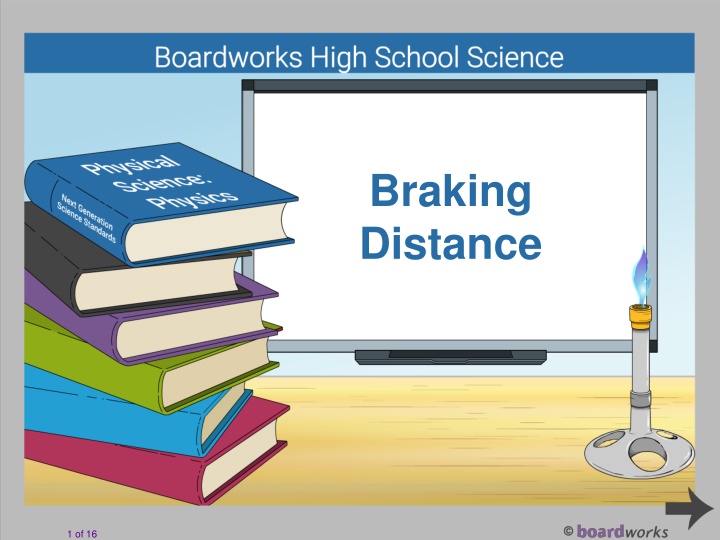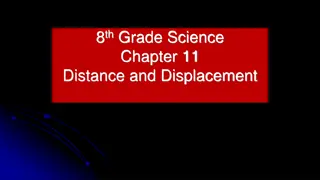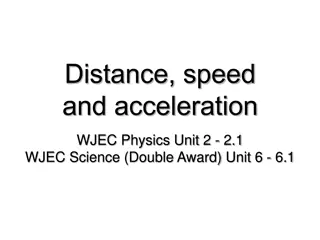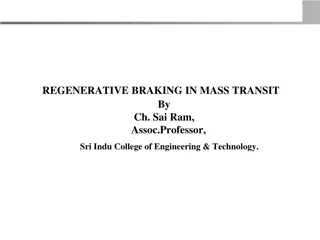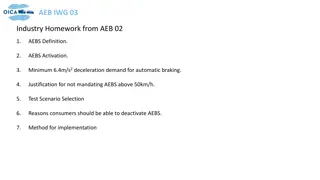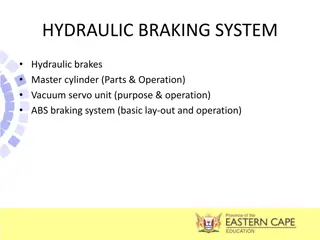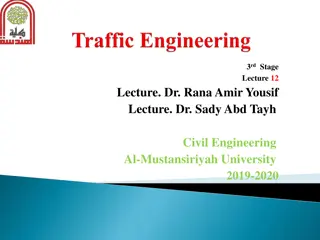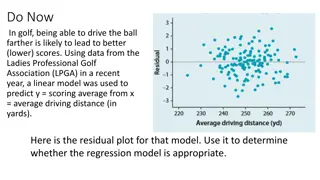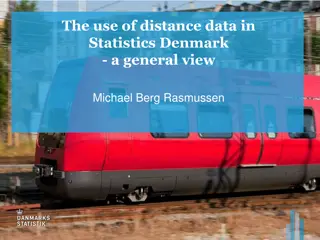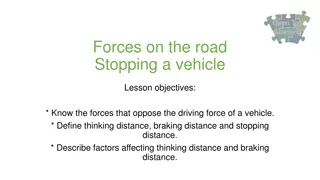Braking Distance
Braking distance is crucial for road safety, composed of thinking distance and actual stopping distance. Learn how brakes work, the role of friction in stopping a vehicle, and the influence of mass and velocity on kinetic energy affecting braking distance. Discover the physics behind braking forces and explore the factors affecting the overall stopping distance of a vehicle.
Download Presentation

Please find below an Image/Link to download the presentation.
The content on the website is provided AS IS for your information and personal use only. It may not be sold, licensed, or shared on other websites without obtaining consent from the author.If you encounter any issues during the download, it is possible that the publisher has removed the file from their server.
You are allowed to download the files provided on this website for personal or commercial use, subject to the condition that they are used lawfully. All files are the property of their respective owners.
The content on the website is provided AS IS for your information and personal use only. It may not be sold, licensed, or shared on other websites without obtaining consent from the author.
E N D
Presentation Transcript
Braking Distance 1 of 16
Information Analyzing and Interpreting Data Using Mathematics and Computational Thinking Constructing Explanations and Designing Solutions 2. Cause and Effect 3. Scale, Proportion, and Quantity 5. Energy and Matter 2 of 16
What is braking distance? Stopping distance is the overall distance that a vehicle takes to stop. It is made up of two parts: thinking distance and braking distance. stopping distance = thinking distance + braking distance Thinking distance is how far the vehicle travels whilst the driver is making the decision to stop. The braking distance is how far the vehicle travels after the driver has applied the brakes. The faster a vehicle is going, the longer it will take to stop. 3 of 16
Braking forces When a vehicle is traveling at a constant velocity, the thrust produced by the engine is balanced by resistive forces. The net force is zero. braking force resistive forces thrust In order to stop the vehicle, the brakes must apply an additional force. When this happens, the forces on the vehicle are no longer balanced and the car decelerates. 4 of 16
How do brakes work? Brakes work through friction. Friction is a resistive force that occurs whenever two surfaces try to move past each other. When brakes are applied, the brake pads are squeezed together and come into contact with the brake discs. Large frictional forces are generated between the brake pads and the brake discs. These oppose the movement of the wheel and the wheel stops spinning. 5 of 16
Work done by frictional forces Because the vehicle has kinetic energy, it takes work to stop it. work done = energy transferred The work done by the brakes to stop the car is equal to the kinetic energy the car had before the brakes were applied. Energy cannot be destroyed, only transformed from one form to another. In this case, the kinetic energy is converted into heat energy. The brake pads and brake discs become hot. 6 of 16
What affects the kinetic energy? The kinetic energy of an object can be calculated using the equation: As mass and velocity increase, the kinetic energy of the object also increases. Therefore, for the same braking force, the stopping distance of a vehicle increases with its mass and velocity. Which do you think has the greater effect: mass or velocity? 7 of 16
Speed and braking distance 8 of 16
Kinetic energy calculation How much work is done by the brakes to bring a 1,750kg car traveling at 30m/s to a stop? work done = energy transferred All of the car s kinetic energy is transferred to heat. KE = mass velocity2 work done = kinetic energy = mv2 = 1,750 302 = 787,500J or 787.5kJ 9 of 16
Braking and deceleration Remember: the faster the vehicle, the more kinetic energy it has. The more kinetic energy it has, the more work needs to be done to bring it to a stop. To do more work over the same braking distance, the force applied by the brakes has to be larger. The more force applied, the faster the car will decelerate. However, large decelerations are dangerous. Brakes can overheat and be damaged if applied too heavily or for too long. 10 of 16
Braking safely Large or sudden decelerations can also injure the people in the vehicle. A large force acting briefly is more of a risk than a moderate force acting over a longer period of time. For this reason, many vehicles have safety features designed to increase the stopping time or stopping distance for the passengers. 11 of 16
Estimating braking forces Estimate the force needed to safely stop a bicycle. a small car. a heavy truck. roughly 15kN around 200N about 5kN 12 of 16
What affects braking distance? What factors other than speed affect braking distance? adverse road conditions poor condition of the vehicle wet or icy weather condition of tires or brakes condition of road 13 of 16
Braking distance and friction When braking, the wheels of the car are in contact with the brakes and the road. If the brakes are worn, this will reduce the amount of friction between the brake pad and the brake disc. The car will take longer to stop. friction from brakes friction from road If the road is slippery, this will reduce the friction between the tire and the road. The car will take longer to stop and be more likely to skid. 14 of 16
Braking quickly In an emergency, drivers need to be able to minimize their braking distance in order to stop quickly. Because of the squared relationship between velocity and braking distance, a small decrease in velocity produces a bigger decrease in braking distance. Drivers are advised to reduce their speed in wet or icy weather. Different speed limits are used on different roads and in different situations. Compare the speed limit on a highway to a street outside a school. 15 of 16
Estimating braking distance Estimate the braking distance for a car traveling at 25mph. 50mph. 100mph. around 10m around 40m around 160m How would these estimates change if the road was wet? 16 of 16
